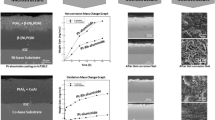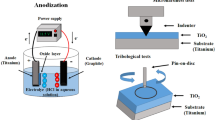Abstract
The effects of small additions of oxide-forming elements (In, Fe, Sn, or Zn) on high-temperature oxidation behaviors and surface oxide colors in experimental Pd-free, Au-Pt-based metal-ceramic alloys for dental applications were investigated by means of spectrophotometric colorimetry, thin-film X-ray diffraction, and field-emission electron probe microanalysis. Three mirror-polished plate samples sized 10 × 10 × 0.5 mm3 from each alloy were subjected to the oxide-forming heat treatments at 950 °C for 10 min in air and then submitted to the above-mentioned investigations. The sole addition of Fe or Sn to the parent Au-10 at.% Pt alloy (AP10) formed very thin external oxide layers of Fe2O3 or SnO2, respectively. Chromaticity indices for these oxidized surfaces largely varied with concentrations of Fe or Sn due to light interference phenomena. On the other hand, the sole addition of In to the parent AP10 alloy developed In2O3 precipitates by the internal oxidation mechanism. Their surface colors did not change significantly regardless of In concentrations. It was highlighted that the combinative addition of 2 at.% In and Fe or Sn to the AP10 alloy well developed In2O3 precipitates in the Au-Pt alloy substrate by the internal oxidation mechanism. Owing to this significant effect of In inclusion, all of the oxidized ternary AP10-In and quaternary (AP10-In2)-Fe/Sn alloys showed similar surface oxide colors with a * coordinates (red-green direction) of nearly +4 and b * coordinates (yellow-blue direction) of nearly +11, which were pale yellow-brown subjectively. Results of this study are expected to be useful in designing esthetic and novel Pd-free, Au-Pt-based metal-ceramic alloys for dental applications.












Similar content being viewed by others
References
O’Brien WJ, Ryge G (1964) Relation between molecular force calculation and observed strengths of enamel-metal interfaces. J Am Ceram Soc 47:5–8
Anusavice KJ, Horner JA, Fairhurst CW (1977) Adherence controlling elements in ceramic-metal systems, I precious alloys. J Dent Res 56:1045–1052
Anusavice KJ, Ringle RD, Fairhurst CW (1977) Adherence controlling elements in ceramic-metal systems, II nonprecious alloys. J Dent Res 56:1053–1061
Phillips RW (1991) Skinner’s science of dental materials, 9th edn. WB Saunders Co, Philadelphia, pp 359–384
van Noort R (1994) Introduction to dental materials. Mosby, London, pp 215–224
Knosp H, Holliday RJ, Corti CW (2003) Gold in dentistry: alloys, uses and performance. Gold Bull 36:93–102
Johnson A, van Noort R, Stokes CW (2006) Surface analysis of porcelain fused to metal system. Dent Mater 22:330–337
Asakura M, Kominami Y, Hayashi T, Tsuruta S, Kawai T (2012) The effect of zinc levels in a gold-based alloy on porcelain-metal bonding. Dent Mater 28:e35–e41
Stavridakis MM, Papazoglou E, Seghi RR, Johnston WM, Brantley WA (2000) Effect of different high-palladium metal-ceramic alloys on the color of opaque porcelain. J Prosthod 9:71–76
Culha O, Zor M, Ali Gungor M, Arman Y, Toparli M (2009) Evaluating the bond strength of opaque material on porcelain fused to metal restorations (PFM) alloys by scratch test method. Mater Design 30:3225–3228
Stavridakis MM, Papazoglou E, Seghi RR, Johnston WM, Brantley WA (2004) Effect of different high-palladium metal-ceramic alloys on the color of opaque and dentin porcelain. J Prosthet Dent 92:170–178
Terada Y, Sakai T, Hirayasu R (1989) The masking ability of an opaque porcelain: a spectrophotometric study. Int J Prosthodont 2:259–264
Shiraishi T, Hisatsune K, Tanaka Y, Miura E, Takuma Y (2001) Optical properties of Au-Pt and Au-Pt-In alloys. Gold Bull 34:129–133
Shiraishi T, Geis-Gerstorfer J (2006) Optical properties of Au-Pt-Pd-based high noble dental alloys. Gold Bull 39:9–15
Wataha JC, Hanks CT (1996) Biological effects of palladium and risk of using palladium in dental casting alloys. J Oral Rehabil 23:309–320
Faurschou A, Menné T, Johansen JD, Thyssen JP (2011) Metal allergen of the 21st century—a review on exposure, epidemiology and clinical manifestations of palladium allergy. Contact Dermatitis 64:185–195
Fischer J, Fleetwood PW (2000) Improving the processing of high-gold metal-ceramic frameworks by a pre-firing heat treatment. Dent Mater 16:109–113
Rudolf R, Zupančič Hartner T, Kosec L, Todorović A, Kosec B, Anžel I (2008) Mechanical properties and microstructure characterisation of Au-Pt dental alloy. Metalurgija 47:317–323
Shiraishi T, Ohta M (2002) Age-hardening behaviors and grain boundary discontinuous precipitation in a Pd-free gold alloy for porcelain bonding. J Mater Sci-Mater Med 13:979–983
Wang JN, Liu WB (2006) A Pd-free high gold dental alloy for porcelain bonding. Gold Bull 39:114–120
Colic M, Stamenkovic D, Anzel I, Lojen G, Rudolf R (2009) The influence of the microstructure of high noble gold-platinum dental alloys on their corrosion and biocompatibility in vitro. Gold Bull 42:34–47
Johnson A, Shiraishi T, Al-Salehi SK (2010) Ion release from experimental Au-Pt-based metal-ceramic alloys. Dent Mater 26:682–687
Johnson A, Shiraishi T, Hurrell-Gillingham K (2011) In vitro biocompatibility of novel Au-Pt-based metal-ceramic alloys. J Oral Sci 53:387–391
Ennaceri H, Erfurt D, Wang L, Köhler T, Taleb A, Khaldoun A, El Kenz A, Benyoussef A, Ennaoui A (2016) Deposition of multifunctional TiO2 and ZnO top-protective coatings for CSP application. Surf Coat Tech 298:103–113
Ohno H, Kanzawa Y (1983) Internal oxidation in gold alloys containing small amounts of Fe and Sn. J Mater Sci 18:919–929
Ohno H, Kanzawa Y, Kawashima I, Shiokawa N (1983) Structure of high-temperature oxidation zones of gold alloys for metal-porcelain bonding containing small amounts of In and Sn. J Dent Res 62:774–779
Cavas M, Gupta RK, Al-Ghamdi AA, Gafer ZH, El-Tantawy F, Yakuphanoglu F (2013) Preparation and characterization of dye sensitized solar cell based on nanostructured Fe2O3. Mater Lett 105:106–109
Kılıc C, Zunger A (2002) Origins of coexistence of conductivity and transparency in SnO2. Phys Rev Lett 88:095501
Feng X, Ma J, Yang F, Ji F, Zong F, Luan C, Ma H (2007) Structural and UV photoluminescence properties of single crystalline SnO2 films grown on α-Al2O3 (0001) by MOCVD. Solid State Commun 144:269–272
Tilley RJD (2011) Colour and the optical properties of materials. John Wiley & Sons, Ltd, Chichester, pp 102–104
Pérez del Pino A, Fernández-Pradas JM, Serra P, Morenza JL (2004) Coloring of titanium through laser oxidation: comparative study with anodizing. Surf Coat Tech 187:106–112
Diamanti MV, Del Curto B, Masconale V, Passaro C, Pedeferri MP (2012) Anodic coloring of titanium and its alloy for jewels production. Color Res Appl 37:384–390
Reser MK (ed) (1964) Phase diagrams for ceramists. The American Ceramic Society, Columbus , p 132Fig 337
Frank G, Brock L, Bausen HD (1976) The solubilities of Sn in In2O3 and of In in SnO2 crystals grown from Sn-In melts. J Cryst Growth 36:179–180
Roth RS (ed) (1995) Phase equilibria diagrams, vol XI. The American Ceramic Society, Westerville , p 131Fig 9305
Yeh TK, Lin KL, Salam B (2009) Improving high-temperature oxidation behaviour of Sn-Zn-Ag-Al-Ga solders. Solder Surf Mt Tech 21:19–23
Barin I (1989) Thermochemical data of pure substances. VCH, Weinheim
Shewmon PG (1983) Transformations in metals. J Williams Book Co, Jenks, pp 380–384
Acknowledgement
The authors are grateful to Ishifuku Metal Industry Co., Ltd. (Tokyo, Japan) for the preparation of sample alloys.
Author information
Authors and Affiliations
Corresponding author
Ethics declarations
Conflict of interest
The authors declare that they have no conflict of interest.
Rights and permissions
About this article
Cite this article
Shiraishi, T., Miyoshi, N., Johnson, A. et al. High-temperature oxidation behaviors and surface oxide color of Pd-free, Au-Pt-based metal-ceramic alloys for dental applications. Gold Bull 50, 93–104 (2017). https://doi.org/10.1007/s13404-017-0200-5
Received:
Accepted:
Published:
Issue Date:
DOI: https://doi.org/10.1007/s13404-017-0200-5




